The Impact of Grid Distortion on the Power Conversion Harmonics of AC/DC Converters in the Supraharmonic Range
Abstract
:1. Introduction
- An experimental setup based on a dSPACE MicroLabBox will be built to study the SH emissions of PFC boost converters as a common example for AC/DC converters.
- Exposing the AC/DC converter to SH with non-integer multiple and documenting the observations.
- Investigating the effect of the DBR of the low voltage AC/DC converters on the harmonics and SHs transfer between the two sides of the DBR.
- Determining the origin of the added emissions in the frequency spectra of the PFC boost current under SH with non-integer multiple in the background distortion.
2. Interference between the SH Components in the Grid and the AC/DC Converters
2.1. DBR Effect on the Harmonics Reflections on Both Sides
2.2. Interference Problem
- The secondary emission current at flows from the AC side of the DC side of the DBR. Consequently, this current is dissolved into an infinite number of components at the DC side as a result of the DBR effect, which appears as a sideband of SH around . The components of that current can be calculated by Equation (4).
- The primary emissions of the AC/DC converter, depicted in black in Figure 4, appear in three parts as [33]:
- ○
- LF distortion.
- ○
- Baseband harmonics at the switching frequency and its integer multiples.
- ○
- Sideband harmonics around the baseband frequencies.
- The frequency differences between the chosen SHs at and the nearest baseband are and , respectively. These differences are shown in green in Figure 4.
- In the LF range, additional emissions appear at and due to the interference between the baseband primary SH and the secondary emission. The additional emissions are drawn in green in Figure 4. Then, these additional emissions flow towards the DBR.
- The additional emissions at and are affected by the DBR function while they cross the DBR to the AC side. They appear as bands of harmonics based on Equation (4). The reflections of added emissions in the AC side of the DBR are as shown in Figure 5.
3. Simulation and Experimental Verification
3.1. System Implementation for Simulation and Experimental Studies
3.2. Simulation Study
3.2.1. Case Study 1: Grid Voltage Distorted with a SH Component at 5029 Hz
3.2.2. Case Study 2: Grid Voltage Distorted with a SH Component at 5038.6 Hz
3.3. Experimental Study
3.3.1. Case Study 1: Grid Voltage Distorted with a SH Component at 5029 Hz
3.3.2. Case Study 2: Grid Voltage Distorted with a SH Component at 5038.6 Hz
4. Conclusions and Future Work
- ○
- Developing a mathematical modeling approach to calculate the additional emissions resulting from the interference between the background voltage distortions in the SH range and the primary emissions of AC/DC converters. However, developing this mathematical model still faces many challenges [30], such as the grid impedance model in SH range still being simulation-based. However, obtaining a mathematical modeling approach in SH range for the grid is essential to predict the amplitudes and phases of this additional emissions which is still missing in literature [30].
- ○
- This study will include the experimental interference in high-power AC/DC converters by taking into account the effect of the equivalent series resistance on the primary emissions of such converters.
- ○
- Studying the effect of the continuous, critical and discontinuous modes on the primary emissions of AC/DC converter as is still missing in the literature [33]. This could help side by side with the grid modeling approach in predicting the effect of the aforementioned modes on the interference.
Author Contributions
Funding
Data Availability Statement
Conflicts of Interest
Abbreviations
| DBR | diode bridge rectifier |
| EMI | electromagnetic interference |
| EV | electric vehicles |
| GCI | grid connected inverters |
| LED | light emitting diode |
| LV | low voltage |
| PE | power electronics |
| PFC | Power Factor Correction |
| RC | ripple control |
| SH | supraharmonic |
| VFD | variable frequency drives |
Variables
| Grid frequency | |
| The frequency of the SH current generated from the background distortion | |
| The amplitude of the SH current generated from the background distortion | |
| Instantaneous SH current generated from the background distortion | |
| The instantaneous reflection of in the DC side of the DBR | |
| Diode bridge rectifier |
References
- Osheba, M.S.; Lashine, A.E.; Mansour, A.S. Design, implementation and performance evaluation of multi-function boost converter. Sci. Rep. 2023, 13, 4276. [Google Scholar] [CrossRef] [PubMed]
- Harbi, I.; Ahmed, M.; Rodriguez, J.; Kennel, R.; Abdelrahem, M. Low-complexity finite set model predictive control for split-capacitor ANPC inverter with different levels modes and online model update. IEEE J. Emerg. Sel. Top. Power Electron. 2022, 11, 506–522. [Google Scholar] [CrossRef]
- Grevener, A.; Meyer, J.; Rönnberg, S.; Bollen, M.; Myrzik, J. Survey of supraharmonic emission of household appliances. CIRED-Open Access Proc. J. 2017, 2017, 870–874. [Google Scholar] [CrossRef]
- Alkahtani, A.A.; Alfalahi, S.T.; Athamneh, A.A.; Al-Shetwi, A.Q.; Mansor, M.B.; Hannan, M.A.; Agelidis, V.G. Power quality in microgrids including supraharmonics: Issues, standards, and mitigations. IEEE Access 2020, 8, 127104–127122. [Google Scholar] [CrossRef]
- Sakar, S.; Rönnberg, S. Modeling and analysis of dc-link capacitors subjected to high frequency conducted disturbances in electronic equipment. IEEE Trans. Power Electron. 2021, 37, 5949–5956. [Google Scholar] [CrossRef]
- CLC/TR 50669:2017; Investigation Results on Electromagnetic Interference in the Frequency Range Below 150 kHz. NSAI Standards, Irish Standard Recommendation, S.R. Gelenec: Dublin, Ireland, 2018; CENELEC SC 205A. CLC/TR 50669. (2017).
- CLC/TR 50627; Study Report on Electromagnetic Interference between Electrical Equipment/Systems in the Frequency Range Below 150 kHz. NSAI Standards, Irish Standard Recommendation, S.R. NSAI: Dublin, Ireland, 2013.
- Alfalahi, S.T.; Alkahtani, A.A.; Al-Shetwi, A.Q.; Al-Ogaili, A.S.; Abbood, A.A.; Mansor, M.B.; Fazea, Y. Supraharmonics in power grid: Identification, standards, and measurement techniques. IEEE Accesss 2021, 9, 103677–103690. [Google Scholar] [CrossRef]
- Aboutaleb, A.M.; Desmet, J.; Knockaert, J. Impact of Grid-Connected Inverter Parameters on the Supraharmonic Emissions in Distributed Power Generation Systems. Machines 2023, 11, 1014. [Google Scholar] [CrossRef]
- Darmawardana, D.; Perera, S.; Meyer, J.; Robinson, D.; Jayatunga, U.; Elphick, S. Development of high frequency (Supraharmonic) models of small-scale (<5 kW), single-phase, grid-tied PV inverters based on laboratory experiments. Electr. Power Syst. Res. 2019, 177, 105990. [Google Scholar]
- Klatt, M.; Stiegler, R.; Meyer, J.; Schegner, P. Generic frequency-domain model for the emission of PWM-based power converters in the frequency range from 2 to 150 kHz. IET Gener. Transm. Distrib. 2019, 13, 5478–5486. [Google Scholar] [CrossRef]
- Espín-Delgado, Á.; Busatto, T.; Ravindran, V.; Rönnberg, S.K.; Meyer, J. Evaluation of supraharmonic propagation in LV Networks based on the Impedance Changes Created by Household Devices. In Proceedings of the 2020 IEEE PES Innovative Smart Grid Technologies Europe (ISGT-Europe), The Hague, The Netherlands, 26–28 October 2020; pp. 754–758. [Google Scholar]
- Sakar, S.; Rönnberg, S.; Bollen, M.H. Immunity test of LED lamps based on IEC 61000-4 19 and unexpected consequence. In Proceedings of the 2018 18th International Conference on Harmonics and Quality of Power (ICHQP), Ljubljana, Slovenia, 13–16 May 2018; pp. 1–6. [Google Scholar]
- Rönnberg, S. Emission and Interaction from Domestic Installations in the Low Voltage Electricity Network, Up to 150 kHz. Ph.D. Thesis, Luleå Tekniska Universitet, Luleå, Sweden, 2013. [Google Scholar]
- Sakar, S.; Rönnberg, S.; Bollen, M. Interferences in AC–DC LED drivers exposed to voltage disturbances in the frequency range 2–150 kHz. IEEE Trans. Power Electron. 2019, 34, 11171–11181. [Google Scholar] [CrossRef]
- IEC 61000-4-19:2014; Part 4-19: Testing and Measurement Techniques—Test for Immunity to Conducted, Differential Mode Disturbances and Signalling in the Frequency Range 2 kHz to 150 kHz at a.c. Power Ports. International Electrotechnical Commission: Geneva, Switzerland, 2014.
- IEEE Recommended Practice and Requirements for Harmonic Control in Electric Power Systems. In IEEE Std 519-2014 (Revision of IEEE Std 519-1992); IEEE: Piscataway, NJ, USA, 2014; pp. 1–29. [CrossRef]
- Electromagnetic Compatibility (EMC) Part 2-2: Environment Compatibility Levels for Low Frequency Conducted Disturbances and Signaling in Public Low-Voltage Power Systems. IEC 61000-2-2, 27 June 2017. Available online: https://webstore.iec.ch/publication/60967 (accessed on 5 June 2024).
- Soltani, H.; Davari, P.; Zare, F.; Blaabjerg, F. Effects of modulation techniques on the input current interharmonics of adjustable speed drives. IEEE Trans. Ind. Electron. 2017, 65, 167–178. [Google Scholar] [CrossRef]
- Ravindran, V.; Busatto, T.; Rönnberg, S.K.; Meyer, J.; Bollen, M.H.J. Time-varying interharmonics in different types of grid-tied PV inverter systems. IEEE Trans. Power Del. 2020, 35, 483–496. [Google Scholar] [CrossRef]
- EN50160; Voltage Characteristics of Electricity Supplied by Public Electricity Networks. German Institute for Standardisation: Berlin, Germany, 2010.
- Drapela, J.; Slezingr, J. Flickering of Lamps Due to Ripple Control Signal. In Proceedings of the 2011 IEEE Trondheim PowerTech, Trondheim, Norway, 19–23 June 2011; pp. 1–7. [Google Scholar]
- Elphick, S.; Perara, S.; Browne, N. Ripple Singal Amplification Measurement, Modelling and Mitigation. Australasian Universities Power Engineering Conference. 2006, pp. 1–6. Available online: https://api.semanticscholar.org/CorpusID:11074685 (accessed on 5 June 2024).
- Espín-Delgado, Á.; Rönnberg, S. Modeling and analysis of supraharmonic propagation for stochastic studies. IEEE Trans. Power Deliv. 2022, 37, 4899–4910. [Google Scholar] [CrossRef]
- Wang, Y.; Luo, D.; Xiao, X. Evaluation of supraharmonic emission levels of multiple grid connected VSCs. IET Gener. Transm. Distrib. 2019, 13, 5597–5604. [Google Scholar] [CrossRef]
- Torquato, R.; Hax, G.T.; Freitas, W.; Nassif, A. Impact assessment of high-frequency distortions produced by PV inverters. IEEE Trans. Power Deliv. 2020, 36, 2978–2987. [Google Scholar] [CrossRef]
- Carbone, R.; Lo Schiavo, A.; Marino, P.; Testa, A. Frequency coupling matrices for multi-stage conversion system analysis. Eur. Trans. Electr. Power 2002, 12, 17–24. [Google Scholar] [CrossRef]
- Li, C.; Xu, W.; Tayjasanant, T. Interharmonics: Basic concepts and techniques for their detection and measurement. Electr. Power Syst. Res. 2003, 66, 39–48. [Google Scholar] [CrossRef]
- Sakar, S.; Rönnberg, S.K.; Bollen, M. Interharmonic emission in AC–DC converters exposed to nonsynchronized high-frequency voltage above 2 kHz. IEEE Trans. Power Electron. 2020, 36, 7705–7715. [Google Scholar] [CrossRef]
- Aboutaleb, A.M.; Gholizad, A.; Desmet, J.; Knockaert, J. Self-induced and Mutual-induced Emissions of Grid-Tied Converters. IEEE J. Emerg. Sel. Top. Power Electron. 2024. [Google Scholar] [CrossRef]
- Testing and Measurement Techniques General Guide on Harmonics and Interharmonics Measurements and Instrumentation, for Power Supply Systems and Equipment Connected Thereto, IEC 61000-4-7, June 2008. Available online: https://webstore.iec.ch/publication/4228#:~:text=IEC%2061000%2D4%2D7%3A2002%2BA1%3A2008,50%20Hz%20and%2060%20Hz (accessed on 5 June 2024).
- Slangen, T.; van Wijk, T.; Ćuk, V.; Cobben, S. The Propagation and Interaction of Supraharmonics from Electric Vehicle Chargers in a Low-Voltage Grid. Energies 2020, 13, 3865. [Google Scholar] [CrossRef]
- Esfetanaj, N.N.; Wang, H.; Blaabjerg, F.; Davari, P. Differential mode noise prediction and analysis in single-phase boost PFC for the new frequency range of 9–150 kHz. IEEE J. Emerg. Sel. Top. Ind. Electron. 2021, 3, 177–187. [Google Scholar] [CrossRef]






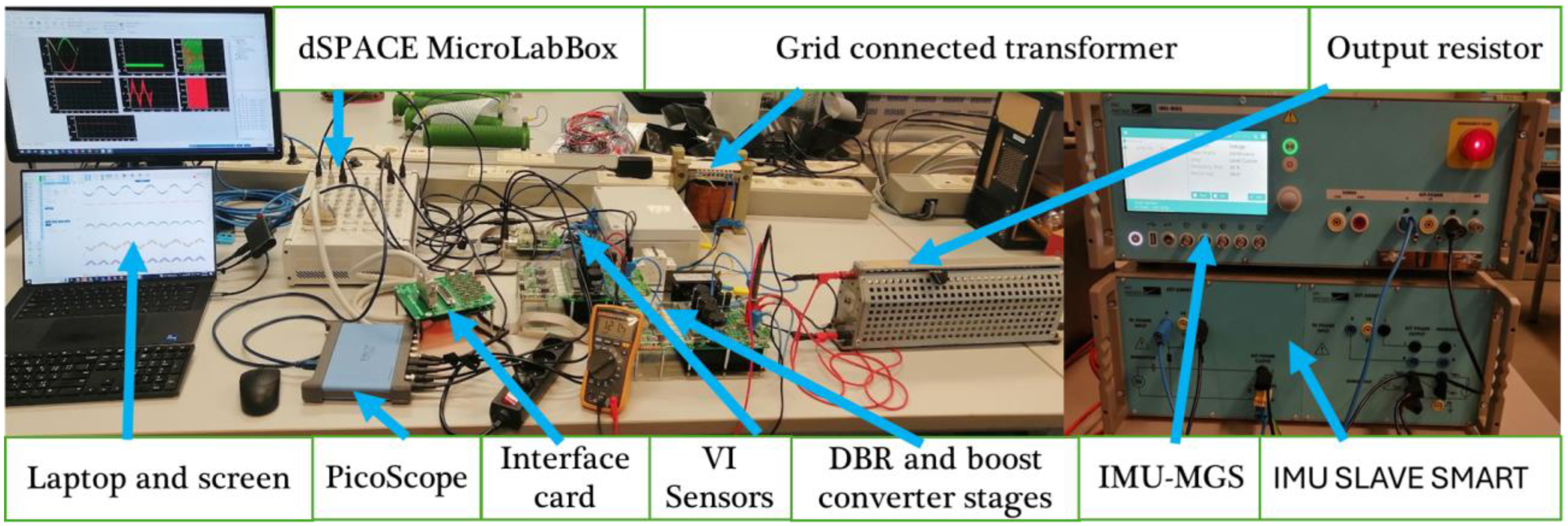




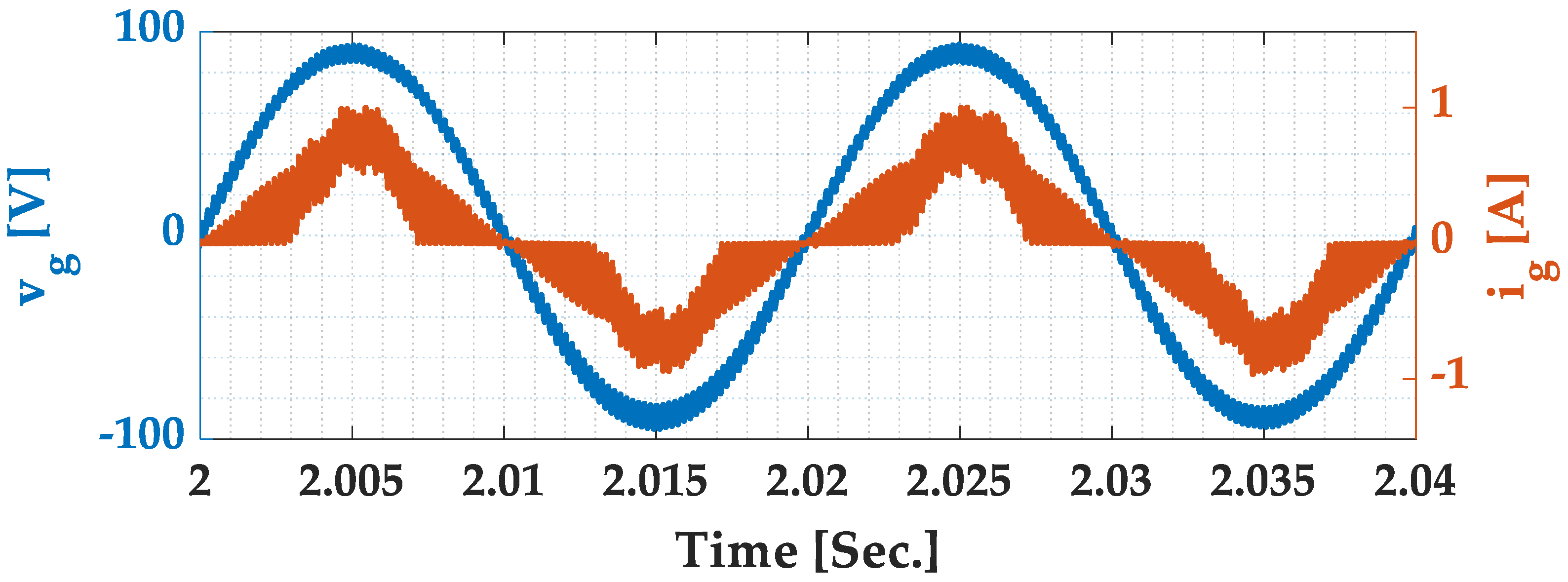
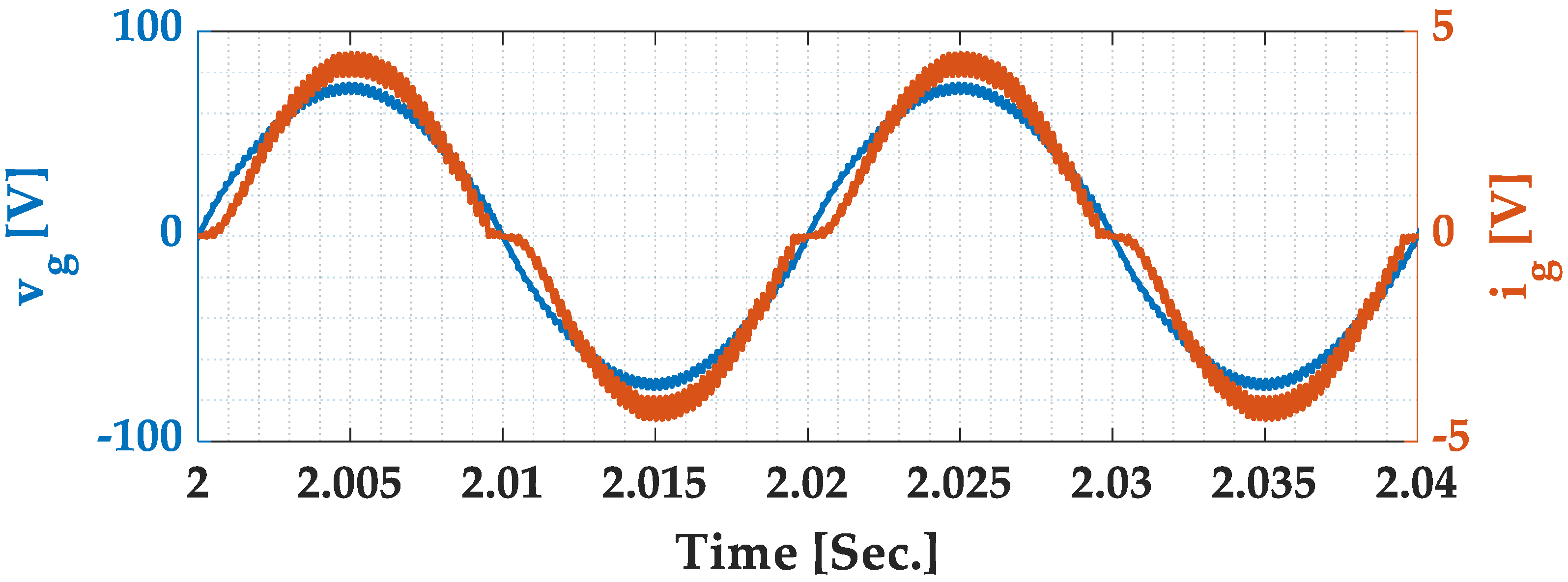
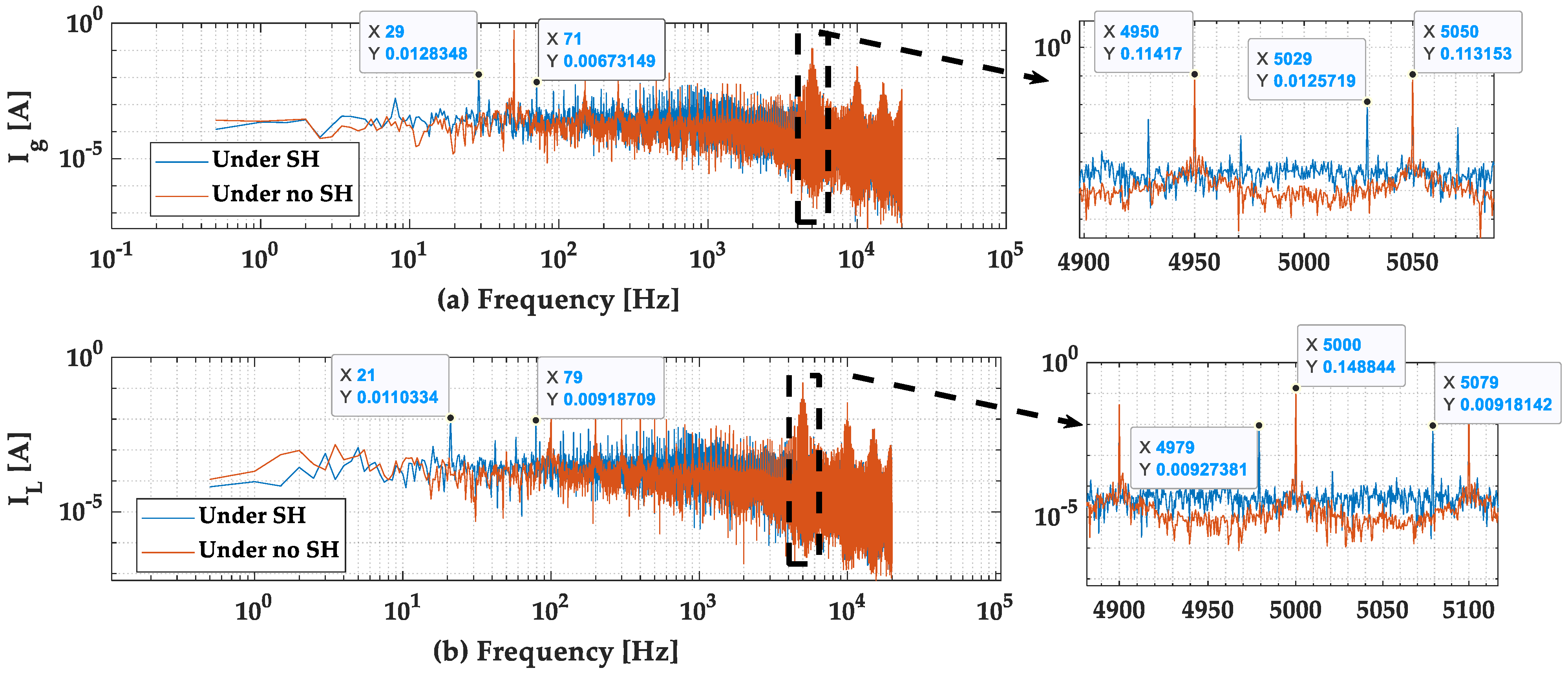
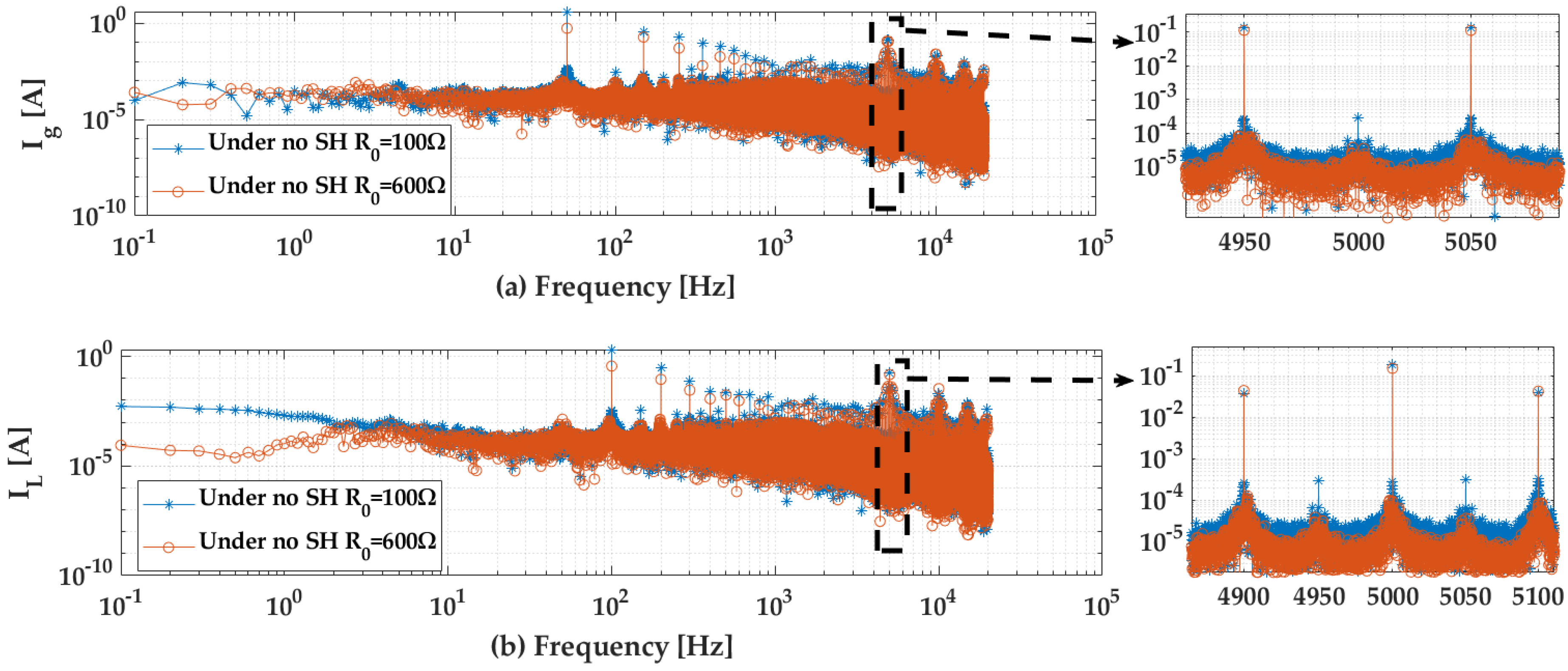
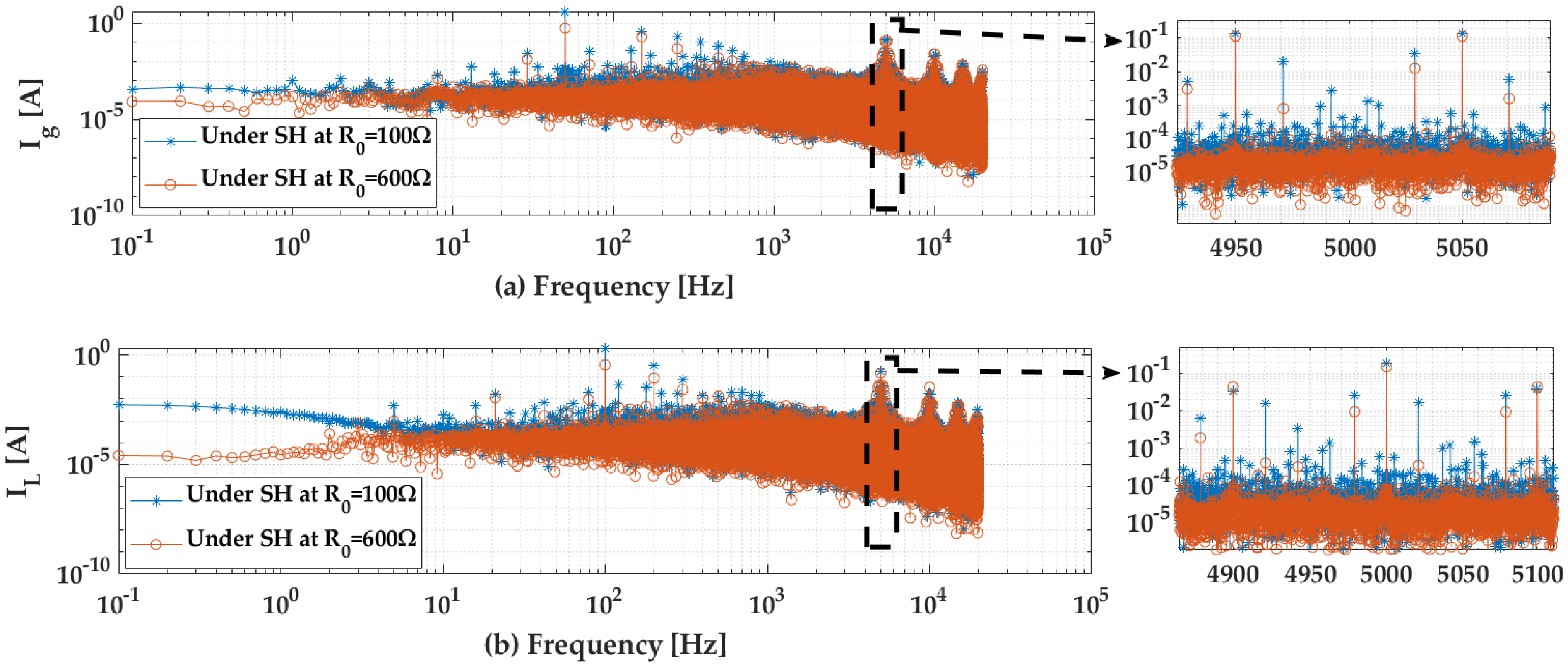

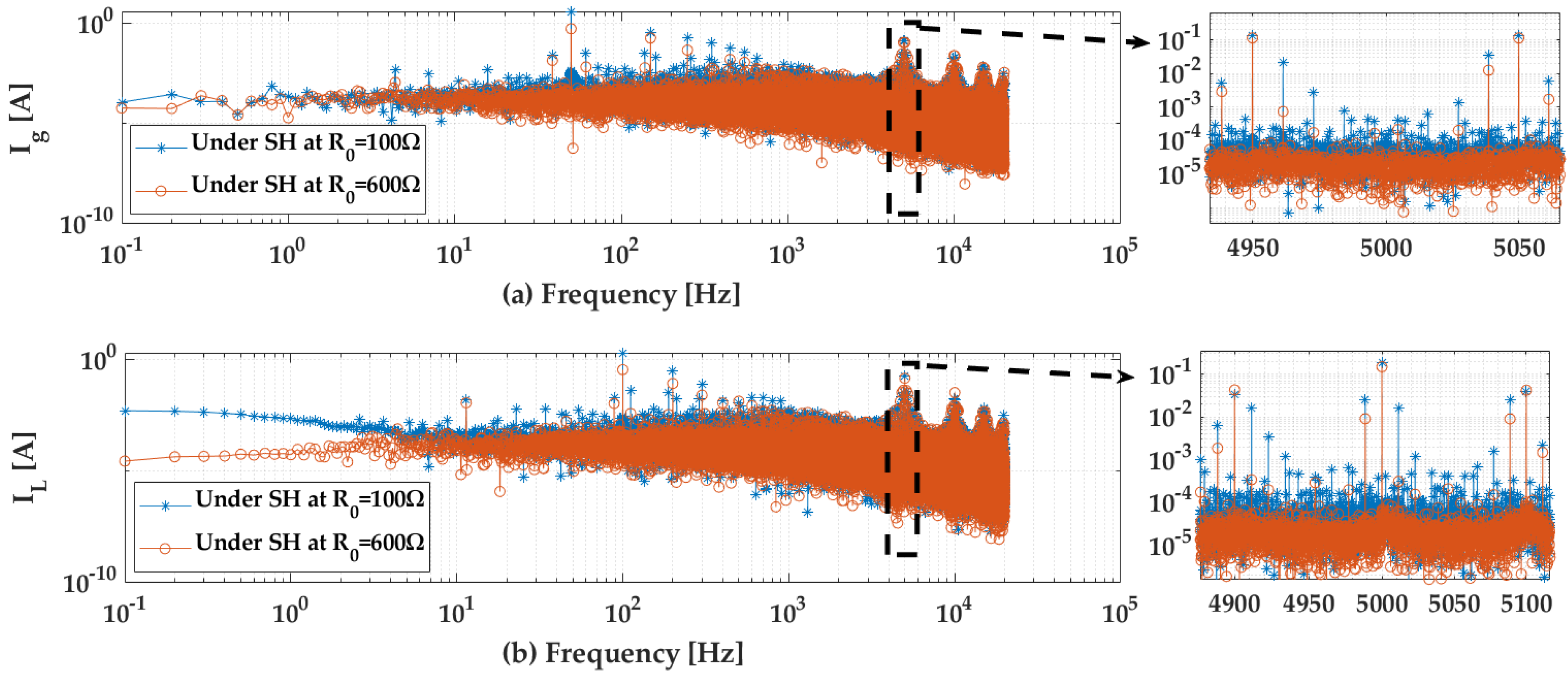


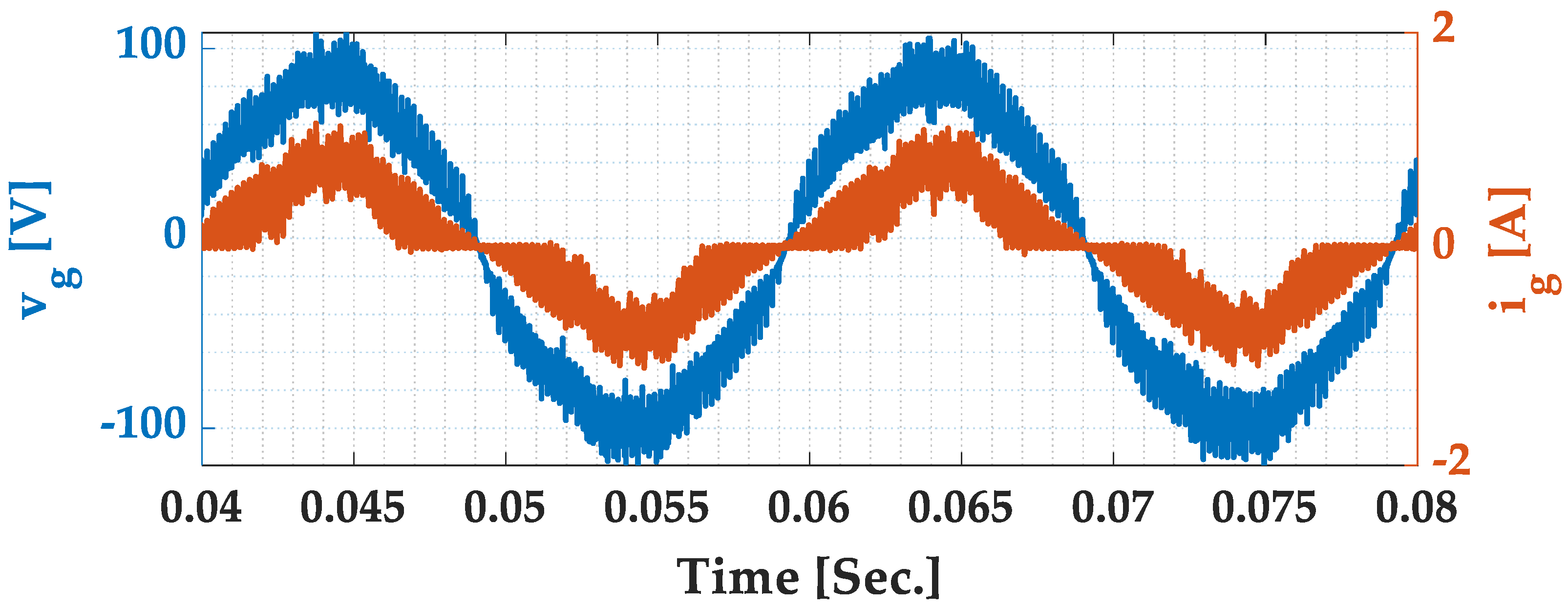
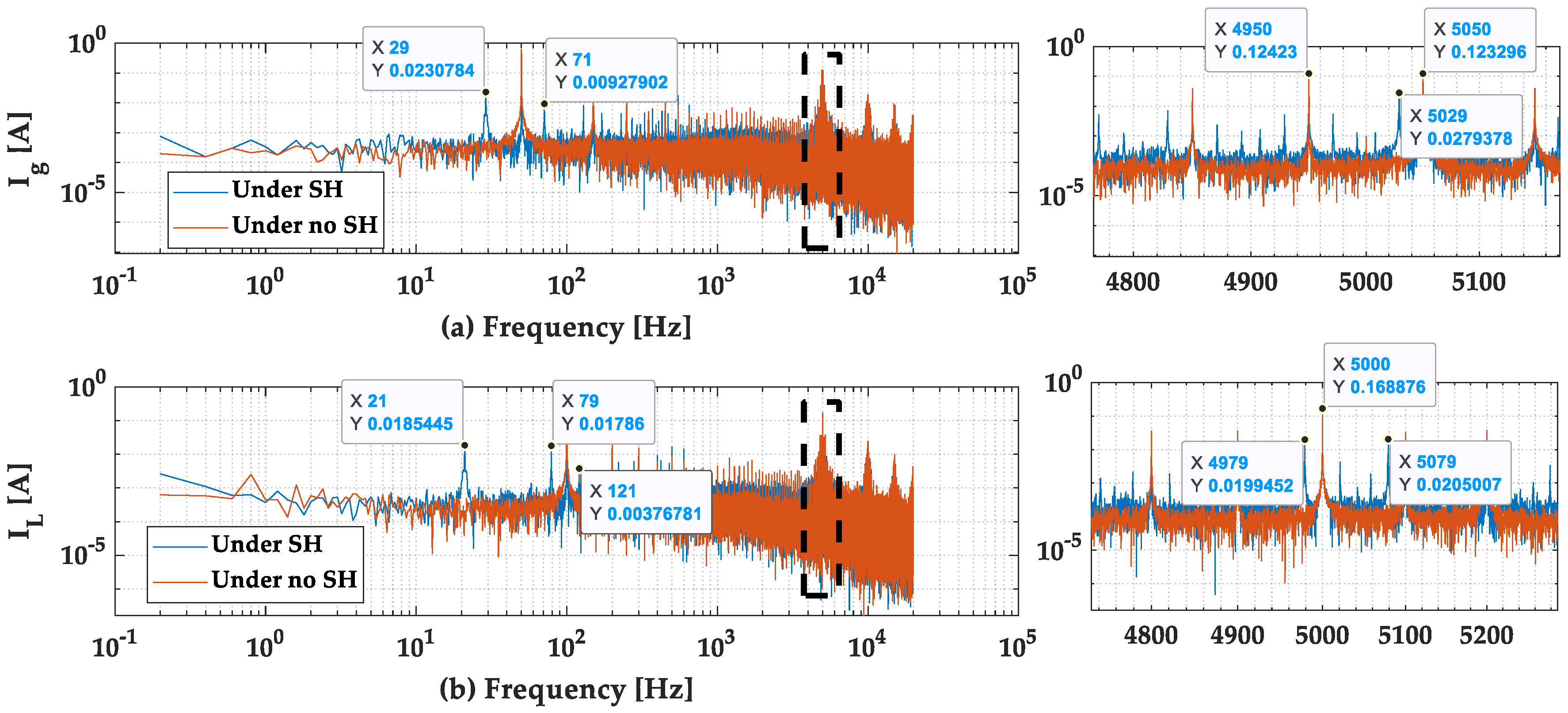
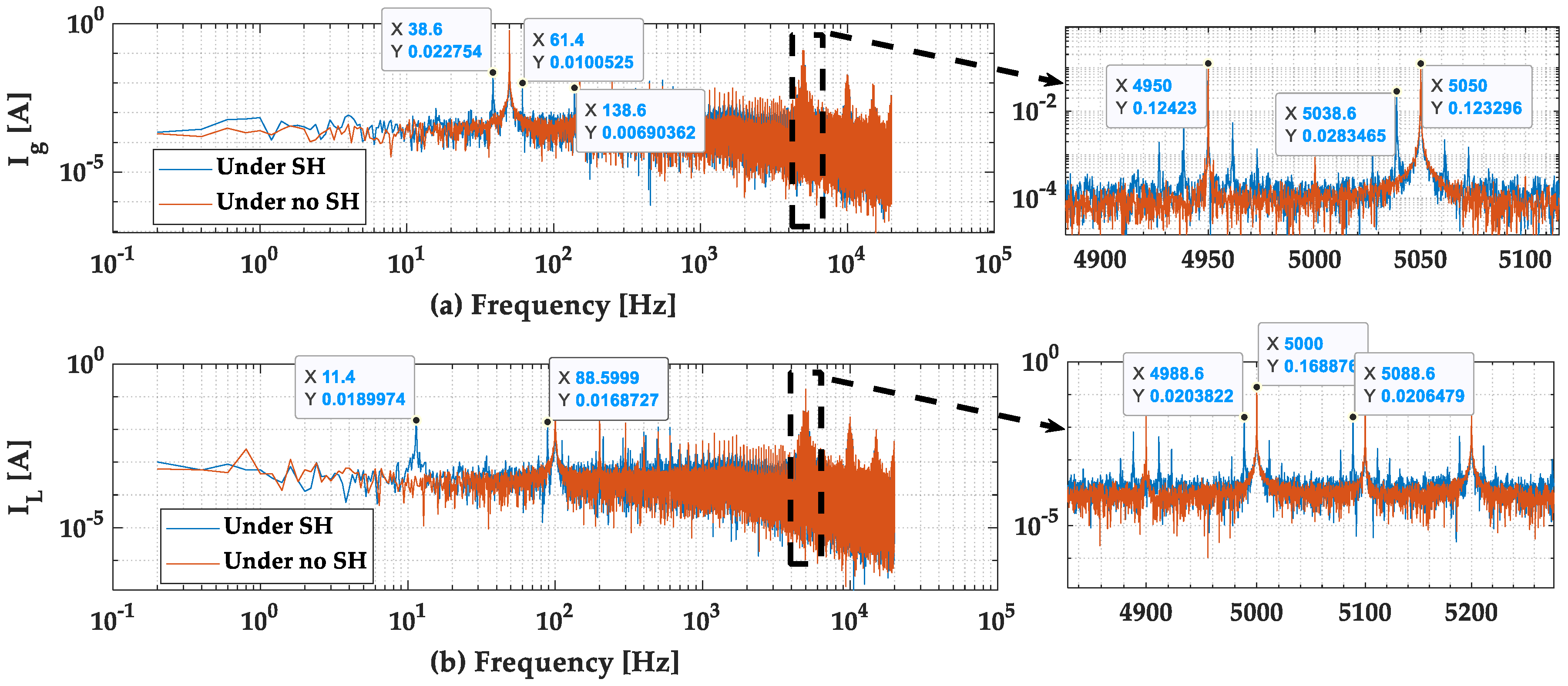
| Parameter | Value |
|---|---|
| Grid Voltage (Root mean square) | |
| Boosting inductance | |
| Boosting capacitor | |
| Output resistor | |
| Switching frequency | |
| Output voltage |
| SH Component Frequency Added to the Grid (Hz) | Main SH Emission Frequency (Hz) | ig(fSH) Components (Hz) | Δf (Hz) | |
|---|---|---|---|---|
| Case Study 1 | 5029 | 5000 | 4979 | 21 |
| 5079 | 79 | |||
| Case Study 2 | 5038.6 | 5000 | 4988.6 | 11.4 |
| 5088.6 | 88.6 |
| Origin Harmonic Frequency in the DC Side (Hz) | Relationship Based on Equation (4) | Added Emissions Frequencies in the AC Side (Hz) | |
|---|---|---|---|
| Case Study 1 | 79 | 29 | |
| 21 | 71 | ||
| Case Study 2 | 88.6 | 38.6 | |
| 11.4 | 61.4 |
Disclaimer/Publisher’s Note: The statements, opinions and data contained in all publications are solely those of the individual author(s) and contributor(s) and not of MDPI and/or the editor(s). MDPI and/or the editor(s) disclaim responsibility for any injury to people or property resulting from any ideas, methods, instructions or products referred to in the content. |
© 2024 by the authors. Licensee MDPI, Basel, Switzerland. This article is an open access article distributed under the terms and conditions of the Creative Commons Attribution (CC BY) license (https://creativecommons.org/licenses/by/4.0/).
Share and Cite
Osheba, M.S.; Aboutaleb, A.M.; Desmet, J.; Knockaert, J. The Impact of Grid Distortion on the Power Conversion Harmonics of AC/DC Converters in the Supraharmonic Range. Electronics 2024, 13, 2244. https://doi.org/10.3390/electronics13122244
Osheba MS, Aboutaleb AM, Desmet J, Knockaert J. The Impact of Grid Distortion on the Power Conversion Harmonics of AC/DC Converters in the Supraharmonic Range. Electronics. 2024; 13(12):2244. https://doi.org/10.3390/electronics13122244
Chicago/Turabian StyleOsheba, Marwa S., Abdellatif M. Aboutaleb, Jan Desmet, and Jos Knockaert. 2024. "The Impact of Grid Distortion on the Power Conversion Harmonics of AC/DC Converters in the Supraharmonic Range" Electronics 13, no. 12: 2244. https://doi.org/10.3390/electronics13122244







